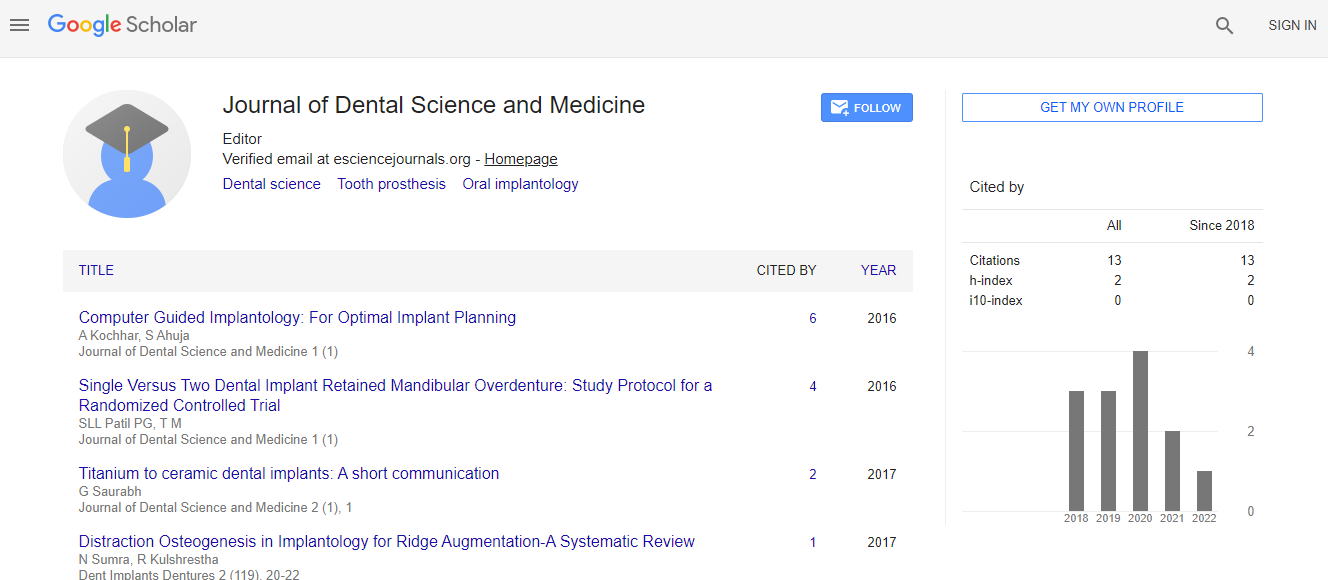Our Group organises 3000+ Global Conferenceseries Events every year across USA, Europe & Asia with support from 1000 more scientific Societies and Publishes 700+ Open Access Journals which contains over 50000 eminent personalities, reputed scientists as editorial board members.
Open Access Journals gaining more Readers and Citations
700 Journals and 15,000,000 Readers Each Journal is getting 25,000+ Readers
Google Scholar citation report
Citations : 13
Journal of Dental Science and Medicine received 13 citations as per Google Scholar report
Indexed In
- RefSeek
- Hamdard University
- EBSCO A-Z
- ICMJE
Useful Links
Recommended Journals
Related Subjects
Share This Page
A three-dimensional virtual analysis versus two-dimensional analysis in evaluation of the complex impactions
29th Annual World Congress on Dental Medicine & Dentistry
Ghada Amin Khalifa
Al-Azhar University, Egypt
Posters & Accepted Abstracts: Dent Implants Dentures
Abstract
Introduction: The radiographic images play a major role in detecting the position of the impacted teeth, shape, orientation, and their relation to the adjacent vital structure. Thus, they facilitate their surgical removal with minimal trauma and minimize the postoperative complications. Plain radiographs provide two-dimensional images that have certain drawbacks. In complex impactions, the missing of certain data may lead to postoperative complications. Objectives: The aim of this study is to compare between the radiographic results of three-dimensional computed tomography (3DCT) which inserted into Simplant software and that of two-dimensional orthopantomograms(OPGs). Material & Methods: A total of 50 abnormally positioned impacted teeth were studied. The shape, position, orientation, and the relation to the adjacent vital structures were studied by using OPGS and 3DCT scans. The correlation between the surgical findings during surgeries and radiographic results was also done. The dataset of the 3DCT scans was inserted and manipulated by Simplant technology to virtually visualize the impacted teeth. Results: Thirty cases were lower impacted wisdom molars, 10 cases were upper impacted third molar, while the impacted upper canine found in 5 cases, and the other 5 cases were impacted lower second premolar. There were no differences between the OPGs and 3DCT scans regarding the orientation of impactions. 3DCT scans were much more precise in determination of the exact location of the teeth in the jaw. The buccal, palatal, or lingual position of the teeth were difficult to be determined in OPGs. The configuration of the roots was better seen by using 3DCT scans. The results of 3DCT scans were also correlated with the surgical findings, during surgeries, more than those of OPGs. Conclusion: It could be concluded that the data which is obtained from 3DCT scans can meet the objectives of the diagnostic images much more than OPGs in diagnosis and determination of the surgical panning for the removal of the complex impacted teeth. Thus, they facilitate their surgical removal with minimal complications, and amplify the documentations that provided to the patient in the consent.Biography
Ghada Amin Khalifa is an Associate Professor of Oral and Maxillofacial Surgery at the Faculty of Dental Medicine, Al Azhar University, Cairo, Egypt since 2012. She has received her BDS, MSc and MD from Faculty of Oral and Dental Medicine Cairo University in 1993, 2000 and 2007 respectively. In addition to teaching, she is regularly doing Oral and Maxillofacial surgeries at Al Zahraa Hospital with a Maxillofacial team work.

 Spanish
Spanish  Chinese
Chinese  Russian
Russian  German
German  French
French  Japanese
Japanese  Portuguese
Portuguese  Hindi
Hindi 